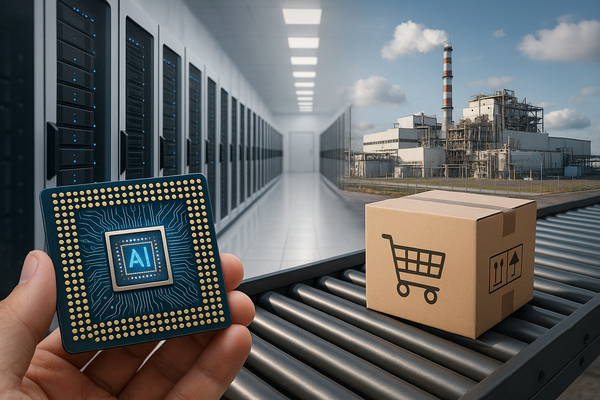
AI hardware deals reset supplier maps. Chipmakers, cloud providers and system builders are signing multibillion-dollar arrangements and expanding factory footprints that matter now because OpenAI, hyperscalers and enterprise customers are accelerating capacity needs. Short-term, markets react to headline-driven stock moves and margin signals; long-term, the industry is scaling new capacity for AI compute, memory and advanced packaging. The U.S. push (Amkor’s $7 billion campus) targets domestic supply; Europe and Asia face renewed competition for foundry, packaging and memory supply. Compared with last year’s quieter capex cycle, 2025 shows faster deal flow and larger server commitments.
“AI partnerships and chip supply shifts”
Big AI contracts are reordering relationships between chip designers and cloud customers. Advanced Micro Devices (NASDAQ:AMD) struck a headline partnership with OpenAI that triggered a one-day share surge of about “24%” and helped push AMD to new market-value milestones. Meanwhile, NVIDIA (NASDAQ:NVDA) is financing customer access in deals that include hardware rentals and special-purpose financing arrangements tied to its GPUs.
Broadcom (NASDAQ:AVGO) reported roughly “$16 billion” of revenue in Q3 FY2025, up about “22%” year-over-year, underscoring how networking and ASIC businesses are benefiting from AI infrastructure demand. Qualcomm (NASDAQ:QCOM) keeps a critical supply tie to Apple (NASDAQ:AAPL) through March 2027 while also buying Arduino to expand its AI and developer ecosystem. These moves show vendors both protecting smartphone routes and pushing into edge and developer software.
However, profit and margin signals vary. Oracle (NASDAQ:ORCL) reported cloud rental revenue of about “$900 million” tied to Nvidia chips but only around “$125 million” of gross profit on those rentals, a detail that has raised questions about the unit economics of renting expensive AI silicon in public clouds.
“Servers, datacenters and capex — Dell and the demand wave”
Server builders and OEMs are revising forecasts to reflect heavier AI spending. Dell Technologies (NYSE:DELL) says AI orders are materially shifting its trajectory: the company raised long-term growth guidance to about “7%–9%” annual sales growth (from “3%–4%”) and said it has doubled a long-range profit outlook through 2029. Shares have reacted — rising roughly “6.4%” over a recent week and about “20.9%” in the prior month — as customers commit to larger server deployments.
Memory and storage suppliers are part of the same story. Micron (NASDAQ:MU) reported a dramatic tailwind in FY25, with revenue up “49%” and a surge in demand for high-bandwidth memory (HBM) used in AI accelerators. In addition, hyperscalers and specialized AI cloud providers are structuring purchases that blend direct chip buys, rental models, and financing — a mix that changes supplier cash flow timing and aftermarket service needs.
In addition, the market has shown friction: reports that cloud rental margins can be slim have pulled back some names and prompted deeper scrutiny of how profitable AI cloud services will be at scale.
“Domestic packaging, jobs and the early US supply push”
On the factory side, capacity moves are concrete. Amkor Technology (NASDAQ:AMKR) has expanded a planned Arizona advanced packaging and test campus to a total outlay of about “$7 billion” across two phases and projects up to “3,000” new jobs. The site aims to be the first high-volume advanced packaging facility in the United States, a strategic response to geopolitically driven incentives to onshore critical parts of the semiconductor supply chain.
Regulatory and legal threads are running alongside investment. A UK tribunal recently heard that Qualcomm’s supply policy is “innocuous and lawful,” as consumer groups questioned vendor power in handset ecosystems. That legal context matters because supplier terms — and ownership of firmware, IP and tooling — affect where and how companies invest in local capacity.
Apple’s (NASDAQ:AAPL) pricing strategy for iPhones — moving away from steep new-unit premiums — may encourage faster upgrade cycles, which in turn sustains ongoing demand for application processors and modem components. Combined with the AI-driven server cycle, those consumer and enterprise demand streams are simultaneously stressing packaging, test capacity, and memory supply.
“Key takeaways to watch now”
- “Deal-driven compute demand is front-loaded.” Large partnerships and financing arrangements are accelerating procurement and creating immediate capacity needs for GPUs, HBM and servers.
- “Domestic advanced packaging is scaling.” The Amkor Arizona investment (~”$7B” and up to “3,000” jobs) marks a tangible move to onshore critical packaging capacity for U.S. AI supply resilience.
Overall, the combined headlines — AMD’s OpenAI pact (NASDAQ:AMD), NVIDIA’s (NASDAQ:NVDA) customer financing, Broadcom’s (NASDAQ:AVGO) revenue growth, Qualcomm’s (NASDAQ:QCOM) Apple (NASDAQ:AAPL) supply tie and acquisition of Arduino, and Dell’s (NYSE:DELL) raised outlook — show a market simultaneously reacting to short-term headline risk and building long-term capacity for AI compute. Watch deal structures, margin disclosures and factory rollouts for the next signals on profitability and supply-chain stress points.












